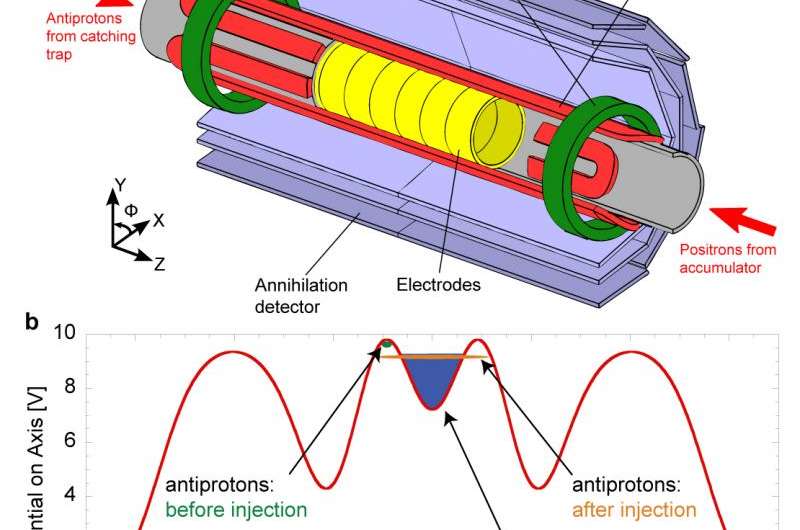Neutral result charges up antimatter research

Scientists of the international ALPHA Collaboration have once again pushed the boundaries of antimatter research with their latest breakthrough studying the properties of antihydrogen. Published today in the prestigious journal Nature, the collaboration's result improved the measurement of the charge of antihydrogen, essentially zero, by a factor of 20. Their work is the latest contribution in the quest to chase down the answer to the basic antimatter question, "If matter and antimatter were created in equal amounts during the Big Bang, where did all the antimatter go?"
"That means the electrical charge of antihydrogen - the antimatter analogue of hydrogen - can be ruled out as the answer to the antimatter question," says York University Professor Scott Menary, an ALPHA member. "The point of the experiment was to search for a clue as to how or where our predictions of nature are wrong," continues Menary. "Something is missing in our understanding otherwise the matter and antimatter at the Big Bang would have annihilated each other and there would be no universe today. The interactions of matter and antimatter must somehow be different."
Physics dictates that for every particle of matter there is an oppositely charged antiparticle with an equal mass. An antihydrogen atom should have the exact same charge as hydrogen (zero). That's because the antiproton and antielectron (positron), which make up antihydrogen, should have the exact opposite charge of the proton and electron that make up hydrogen.
Dr. Andrea Capra, a former PhD student of Menary's (now at TRIUMF) who played a major role in the analysis behind this result, says, "We take the charge of matter and antimatter for granted, however, you cannot analyze data or make an experiment assuming it's true."

This result showed that antihydrogen and hydrogen are indeed both electrically neutral at a level 20 times more precise than before. Since the antiproton charge is also known to a similar precision, the collaboration also has improved the previous best precision on the positron charge by a factor of 25. While both results uphold the Standard Model, they have constrained what possible extensions to it could be.
Capra points out that this work addresses one piece of a larger puzzle. When comparing normal matter to antimatter, he says that "there is the piece comparing their charges, the piece comparing their light spectrums, and the piece comparing how they respond to gravity." The latter piece will be investigated by a dedicated experiment, ALPHA-g, spearheaded by the University of Calgary and including the Canadian members of the collaboration.
The experiment was the first using the upgraded "ALPHA-2" system which began operation last year. The largest component, the cooling cryostat, was designed and built at TRIUMF and the University of Calgary by a team led by Mechanical Research Engineer Cam Marshall and Research Scientist (now Emeritus) Art Olin. Scientists at Simon Fraser University and the University of British Columbia also contributed to the construction and assembly of the ALPHA-2 apparatus, including the cryostat.
Marshall explained that "the cryostat houses a unique octopole magnet with the antimatter trap, into which was fed the laser spectroscopy system, microwave system, liquid helium cooling, super-conducting current leads, diagnostic wiring, and thermal shielding. A lot going on in a small space!" According to Olin, the experiment's success was "facilitated by the stable cryogenic environment and higher trapping rate of this new atom trap." The experiment was tricky because the team had to isolate the antihydrogen within a sophisticated "magnetic bottle" without it coming into contact with matter as it would then annihilate and disappear.
Having passed the first test of their upgraded apparatus with flying colours, the ALPHA Collobration is anxious to attack the other even more exciting pieces of the antimatter puzzle in the coming years.
"We will now look at the other pieces of the puzzle, such as the colour of the light emitted by antihydrogen, and test whether hydrogen and antihydrogen emit light in the same way," says Capra. "We are also working on measuring the gravitational acceleration of antihydrogen and determining whether matter and antimatter have the same gravitational behaviour. The next several years are going to be very exciting."
More information: M. Ahmadi et al. An improved limit on the charge of antihydrogen from stochastic acceleration, Nature (2016). DOI: 10.1038/nature16491
Provided by York University




















